Ghosts of Holidays Past:
Interview with Kim Balaschak
by Josh Wilson
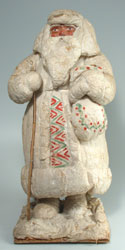 The expat community in Moscow functions much like a smaller town in the US, where the degrees of separation between individuals rarely total more than two. So it was that my email address had crossed Kim Balaschak’s computer (through a mutual Russian acquaintance) and I received a mass email announcing that Kim had a collection of antique Russian and Soviet holiday ornaments on display at a local shopping mall. The interest of my inner social-historian was sparked and our degrees of separation would soon be reduced from one to zero.
The expat community in Moscow functions much like a smaller town in the US, where the degrees of separation between individuals rarely total more than two. So it was that my email address had crossed Kim Balaschak’s computer (through a mutual Russian acquaintance) and I received a mass email announcing that Kim had a collection of antique Russian and Soviet holiday ornaments on display at a local shopping mall. The interest of my inner social-historian was sparked and our degrees of separation would soon be reduced from one to zero.
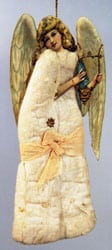 Like most serious collectors, Kim is an expert on the entire subject of what she collects. I listened to her talk in detail about the history of holiday ornaments, with impressive amounts of names and dates and mediums from memory. But the history also bifurcated into several beautifully interrelated levels – mingling her own long and interesting history in Russia with the history of Russia itself as reflected in her collection. Her pleasant and dignified Massachusetts accent mingled with the scores of Russian conversations that surrounded us in one of Moscow’s comfortable Шоколадница coffee houses.
Like most serious collectors, Kim is an expert on the entire subject of what she collects. I listened to her talk in detail about the history of holiday ornaments, with impressive amounts of names and dates and mediums from memory. But the history also bifurcated into several beautifully interrelated levels – mingling her own long and interesting history in Russia with the history of Russia itself as reflected in her collection. Her pleasant and dignified Massachusetts accent mingled with the scores of Russian conversations that surrounded us in one of Moscow’s comfortable Шоколадница coffee houses.
Her collection began in 1998. She had moved to Moscow in 1995 with her husband, Jim, who had been promoted to general manager of the international division of a large western company. He is now the head of consulting for Deloitte & Touche in the CIS. She herself had left behind a job with Shaw’s Supermarkets in the labor department, assuring that the chain’s labor practices stayed efficient. In 1998, they decided to stay in Russia for the holidays for the first time and marked the event with an artificial tree and store-bought ornaments. The next year, Kim decided something with a little more character was in order and so, like savvy shoppers still do in Moscow, she went to Izmailovsky Park.
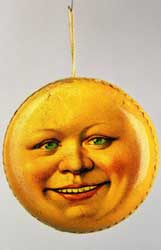 Today, Izmailovsky is a series of individual antiques and crafts dealers, keeping shop inside towering heavy-log kiosks made to look like an idealized Russian market from centuries past. Then, she says, it was more like a mass yard sale, with scores of people selling possessions out of boxes hauled in on the cheap commuter rail. On that cold November day, she found a woman who was selling a string of colored-glass garland and a small Father Frost figurine.
Today, Izmailovsky is a series of individual antiques and crafts dealers, keeping shop inside towering heavy-log kiosks made to look like an idealized Russian market from centuries past. Then, she says, it was more like a mass yard sale, with scores of people selling possessions out of boxes hauled in on the cheap commuter rail. On that cold November day, she found a woman who was selling a string of colored-glass garland and a small Father Frost figurine.
The woman, as part of her sales pitch, also told Kim the story behind the decorations. They were both traditional and from her childhood. Children were not allowed to place the glass garland  around the tree, as the beads tended to be irregularly pinched from glass rods with the ends left rough. The garland also tended to chip in storage the way modern strings of lights tangle and break, creating an even larger liability. However, the soft Father Frost – whose pressed cotton-batting form was supported by a cardboard frame and a coating similar to hairspray – had been all hers as child. Every year, when the tree was nearly done, she would place it under as the finishing touch. These decorations had been factory-produced in the Soviet Union and nearly every family had them, she said.
around the tree, as the beads tended to be irregularly pinched from glass rods with the ends left rough. The garland also tended to chip in storage the way modern strings of lights tangle and break, creating an even larger liability. However, the soft Father Frost – whose pressed cotton-batting form was supported by a cardboard frame and a coating similar to hairspray – had been all hers as child. Every year, when the tree was nearly done, she would place it under as the finishing touch. These decorations had been factory-produced in the Soviet Union and nearly every family had them, she said.
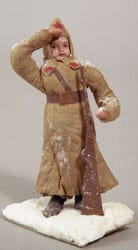 Kim purchased them for fewer than two dollars. The woman working next-box sensed her interest and, grinning with gold teeth, uttered what might have been a magic spell in fairytales. “Ты соберешь игрушки?” (Do you collect toys?) The old woman boasted that at home she had a box of the most wonderful decorations and that she would bring them the next week if Kim would come back. The next week, Kim bought the box.
Kim purchased them for fewer than two dollars. The woman working next-box sensed her interest and, grinning with gold teeth, uttered what might have been a magic spell in fairytales. “Ты соберешь игрушки?” (Do you collect toys?) The old woman boasted that at home she had a box of the most wonderful decorations and that she would bring them the next week if Kim would come back. The next week, Kim bought the box.
Word spread about Kim’s new interest and soon everyone knew her – bringing boxes and boxes and calling her over when they recognized the description of the strange American woman who paid money for old decorations. However, it wasn’t just that the collection had found Kim – very soon into the process, Kim realized that what she was gathering was very special. They were unique artifacts revealing the culture and history of the civilization she was now living in, reflecting it through one of their happiest and most hopeful holidays.
The collection, now thousands of artifacts strong, spans Russian history from pre-revolutionary times to the 1960s.
 It begins with religious themes: angels and biblical animals – often made of paper pieces elaborately inked in Germany, imported to Russia, and assembled onto bodies of cotton batting by local workers. Other early pieces have pagan roots, with representations of the sun and the cock (the guardian of the new day), showing Russia’s understandable obsession with the sun and warmth during cold winter months. That both might appear on the same tree is representative of Russia’s unique history of двоеверие.
It begins with religious themes: angels and biblical animals – often made of paper pieces elaborately inked in Germany, imported to Russia, and assembled onto bodies of cotton batting by local workers. Other early pieces have pagan roots, with representations of the sun and the cock (the guardian of the new day), showing Russia’s understandable obsession with the sun and warmth during cold winter months. That both might appear on the same tree is representative of Russia’s unique history of двоеверие.
Examples from 1917-1935 are hard to find. First the Revolution and later the Civil War cut off trade and halted the production of ornaments. Kim’s collection also includes a copy of “Komsomolskoe Rozhdetsvo” (Komsomol Christmas), which details how communist traditions should usurp religious traditions – including carols, pageants, and everything else. The pamphlet was published in 1925, the same that the USSR semi-officially banned Christmas and its companion, New Year.
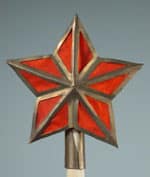 In 1935 it was, for whatever reason, decided that workers might work harder if they were allowed a New Year holiday, albeit without Christmas, and the end of the prohibition was announced on Dec 28th, 1935. People celebrated that New Year’s with the gusto that had once been spent on New Year’s and Christmas – including the production of ornaments.
In 1935 it was, for whatever reason, decided that workers might work harder if they were allowed a New Year holiday, albeit without Christmas, and the end of the prohibition was announced on Dec 28th, 1935. People celebrated that New Year’s with the gusto that had once been spent on New Year’s and Christmas – including the production of ornaments.
 At first, ornaments were simple – depicting traditional (but completely non-religious) Russian passions. They depicted animals and nature, as well as people in traditional winter activities and in the various winter clothing of the peoples of the Soviet Union. Soon production diversified as the economy improved and new sources of inspiration were applied. Red stars made out of metal frames and red fabric topped the trees. Balls with Marx, Engles, Lenin, and Stalin were hung on the branches. Ornaments often reflected (not surprisingly) the values of labor and military might – small figures of parachutists and workers were hung.
At first, ornaments were simple – depicting traditional (but completely non-religious) Russian passions. They depicted animals and nature, as well as people in traditional winter activities and in the various winter clothing of the peoples of the Soviet Union. Soon production diversified as the economy improved and new sources of inspiration were applied. Red stars made out of metal frames and red fabric topped the trees. Balls with Marx, Engles, Lenin, and Stalin were hung on the branches. Ornaments often reflected (not surprisingly) the values of labor and military might – small figures of parachutists and workers were hung.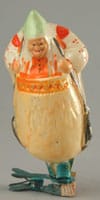
With WWII, there was an explosion of soldiers and armored vehicles, though as the war dragged on, production returned to more folk-affair, with smalls figures made from whatever spare scraps at home. Kim’s husband had some questions about one sad piece – a man that might be Father Christmas made from a scrap of one substance the Soviets never seemed to run short of – medical gauze.
After the war, large-scale production of ornaments returned and, as the Soviet economy picked up steam in the 50s and 60s, themes because more playful. Images of vegetables (the product of labor) appeared, as did arctic exploration, space travel, and circus themes, all mixed with the traditional images from nature and, of course, Father Frost. 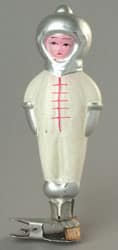 Then, in the 70s, another sign of the times appeared – plastic ornaments. Saying that artificial mediums just don’t hold the same flare of traditional culture, it is here that Kim’s personal interest wanes and her collection stops – covering decades of history and themes.
Then, in the 70s, another sign of the times appeared – plastic ornaments. Saying that artificial mediums just don’t hold the same flare of traditional culture, it is here that Kim’s personal interest wanes and her collection stops – covering decades of history and themes.
Kim is now devoting herself to the collection – and searching for a permanent exhibition space for it, preferably in the Boston area. However, (to complete her personal history) it would be a mistake to think of this as the occupation of a bored housewife. Kim is an energetic professional who has put her skills as a labor efficiency expert to use in 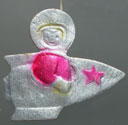 various Russian businesses, including helping to streamline a Moscow fitness-wear manufacturer and participating in a European Bank for Reconstruction and Development project to restructure a Nizhniy Novgorod pharmaceuticals producer. Her “игрушки” are her passion and, having heard the stories surrounding them, I can fully understand how one can become passionate at them – the way some become passionate about soccer or football; I felt that I knew something more about the Russia I live in, its history and people, its traditions and culture, and of course, its ornaments.
various Russian businesses, including helping to streamline a Moscow fitness-wear manufacturer and participating in a European Bank for Reconstruction and Development project to restructure a Nizhniy Novgorod pharmaceuticals producer. Her “игрушки” are her passion and, having heard the stories surrounding them, I can fully understand how one can become passionate at them – the way some become passionate about soccer or football; I felt that I knew something more about the Russia I live in, its history and people, its traditions and culture, and of course, its ornaments.





